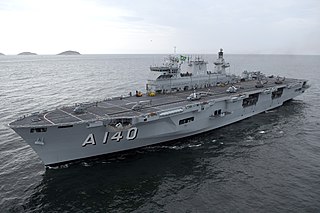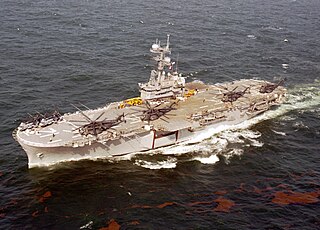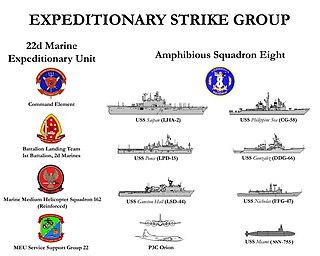The escort carrier or escort aircraft carrier, also called a "jeep carrier" or "baby flattop" in the United States Navy (USN) or "Woolworth Carrier" by the Royal Navy, was a small and slow type of aircraft carrier used by the Royal Navy, the Royal Canadian Navy, the United States Navy, the Imperial Japanese Navy and Imperial Japanese Army Air Force in World War II. They were typically half the length and a third the displacement of larger fleet carriers, slower, more-lightly armed and armored, and carried fewer planes. Escort carriers were most often built upon a commercial ship hull, so they were cheaper and could be built quickly. This was their principal advantage as they could be completed in greater numbers as a stop-gap when fleet carriers were scarce. However, the lack of protection made escort carriers particularly vulnerable, and several were sunk with great loss of life. The light carrier was a similar concept to the escort carrier in most respects, but was fast enough to operate alongside fleet carriers.

USS Iwo Jima (LHD-7) is a Wasp-class amphibious assault ship of the United States Navy. The ship was named for the Battle of Iwo Jima of World War II. The ship was commissioned in 2001 and is in service.

USS Iwo Jima (LPH-2) was the lead ship of her class and type and the first amphibious assault ship to be designed and built from the keel up as a dedicated helicopter carrier. She carried helicopters and typically embarked USMC elements of a Marine Amphibious Unit (MAU)/later Marine Expeditionary Unit (MEU) principally the Aviation Combat Element (ACE) to conduct heliborne operations in support of an amphibious operation. There was no well deck to support landing craft movement of personnel or equipment to/from shore. Iwo Jima was the second of three ships of the United States Navy to be named for the Battle of Iwo Jima, although the first to be completed and see service.

USS Guadalcanal (LPH-7), the third Iwo Jima-class amphibious assault ship (helicopter), was launched by the Philadelphia Naval Shipyard 16 March 1963, sponsored by Zola Shoup, wife of General Shoup, the former Commandant of the Marine Corps; and commissioned 20 July 1963. It was the second ship in the Navy to bear the name.

USS Guam (LPH-9), was an Iwo Jima-class amphibious assault ship, and was laid down by the Philadelphia Naval Shipyard on 15 November 1962; launched on 22 August 1964, sponsored by Mrs. Vaughn H. Emory Green, and commissioned on 16 January 1965. She was the third US Navy ship to carry the name, after the US Territory of Guam.

Landing platform helicopter (LPH) is a term used by some navies to denote a type of amphibious warfare ship designed primarily to operate as a launch and recovery platform for helicopters and other VTOL aircraft. As such, they are considered a type of helicopter carrier.

USS Inchon (LPH/MCS-12) was an Iwo Jima-class amphibious assault ship of the United States Navy in service from 1970 to 2002. Following a major fire, she was laid up and sunk as a target in 2004.

USS Hutchins (DD-476), was a Fletcher-class destroyer, of the United States Navy named after Naval aviator Lieutenant Carlton B. Hutchins (1904–1938), who though mortally injured, was able to remain at the controls of his aircraft and allow his surviving crew to parachute to safety and was posthumously awarded the Medal of Honor.
A joint support ship (JSS) is a multi-role naval vessel capable of launching and supporting joint amphibious and airlift operations. It can also provide command and control, sealift and seabasing, underway replenishment, disaster relief and logistics capabilities for combined land and sea operations.

A helicopter carrier is a type of aircraft carrier whose primary purpose is to operate helicopters. It has a large flight deck that occupies a substantial part of the deck, which can extend the full length of the ship like HMS Ocean of the Royal Navy (RN), or extend only partway, usually aft, as in the Soviet Navy's Moskva class or in the Chinese Navy's Type 0891A. It often also has a hangar deck for the storage of aircraft.

The Dokdo-class amphibious assault ship is a class of landing platform helicopter (LPH) and amphibious assault ships operated by the Republic of Korea Navy (ROKN). It was designed and built by Hanjin Heavy Industries (HHIC), and were meant to enhance South Korea's amphibious operation capability in terms of assault and military operations other than war (MOOTW).

In the United States Navy, the expeditionary strike group (ESG) is a coordinated group of surface ships, aircraft, submarines, and other naval assets. In contrast to carrier strike groups (CSGs), which emphasize air power and are led by a supercarrier, ESGs are strongly suited for amphibious warfare and are led by an amphibious assault ship. The ESG concept was introduced in the early 1990s, based on the Naval Expeditionary Task Force. The U.S. Navy fields nine expeditionary strike groups.

An amphibious assault ship is a type of amphibious warfare ship employed to land and support ground forces on enemy territory during an amphibious assault. The design evolved from aircraft carriers converted for use as helicopter carriers. Modern designs support amphibious landing craft, with most designs including a well deck. Coming full circle, some amphibious assault ships also support V/STOL fixed-wing aircraft, now having a secondary role as aircraft carriers.

An amphibious warfare ship is an amphibious vehicle warship employed to land and support ground forces, such as marines, on enemy territory during an amphibious assault.

The Blue Ridge class is the first and only class of amphibious command and control ships to be specifically designed as such from the keel up.

The Essex class was a class of aircraft carriers of the United States Navy. The 20th century's most numerous class of capital ship, the class consisted of 24 vessels, which came in "short-hull" and "long-hull" versions. Thirty-two ships were ordered, but as World War II wound down, six were canceled before construction, and two were canceled after construction had begun. Fourteen saw combat during World War II. None were lost to enemy action, though several sustained crippling damage. Essex-class carriers were the backbone of the U.S. Navy from mid-1943 and, with the three Midway-class carriers added just after the war, continued to be the heart of U.S. naval strength until supercarriers joined the fleet in the 1950s, 1960s and 1970s. Several of the carriers were rebuilt to handle heavier and faster aircraft of the early jet age, and some served until well after the Vietnam War.

The Ship Characteristics Board was a unit of the United States Navy.















